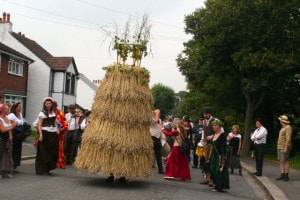Wicker Man
SKU:
£17.85
£17.85
Unavailable
per item
Gildan, 100% cotton.
The illustration for this design is taken from Aylett Sammes Antiquities of Ancient Britain published in 1676. Sammes was strongly influenced by Julius Caesar’s account of human sacrifice by the Britons in his Commentaries on the Gallic War whereby, “unless for a man’s life a man’s life be paid, the majesty of the immortal gods may not be appeased.” He went on to describe “figures of immense size, whose limbs, woven out of twigs, they fill with living men and set on fire, and the men perish in a sheet of flame.” His account may be apocryphal, but the legend lives on and the image remains an immensely powerful one.
The legend of the Wicker Man was of course solidified in Robin Hardy’s film from 1973 which featured Edward Woodward, Christopher Lee and Brit Ekland. The film has become something of a modern touchstone with its' images of pagan rituals and folk noir themes.
You can read more about the contruction of the wicker figure here at he excellent A Year in the Country website and blog:
http://ayearinthecountry.co.uk/ether-signposts-2652a-constructing-wicker-man/
There are further musings on the soundtrack by Adam Scovell at, appropriately enough, celluoidwickerman.com
The burning of straw figures continues to this day. The best known of these is probably the Whittlesea Straw Bear Festival, which traditionally took place on the Tuesday immediately following Plough Monday in early January. It experienced a revival towards the end of the last century and you can read more about it by following the link below:
http://www.strawbear.org.uk/history-whittlesea-straw-bear-festival.html
In a similar fashion the Carshalton Straw Jack in September is made from the last straw of the harvest and then ceremonially burned at the end of the day.
Neither event involves human sacrifice.
The legend of the Wicker Man was of course solidified in Robin Hardy’s film from 1973 which featured Edward Woodward, Christopher Lee and Brit Ekland. The film has become something of a modern touchstone with its' images of pagan rituals and folk noir themes.
You can read more about the contruction of the wicker figure here at he excellent A Year in the Country website and blog:
http://ayearinthecountry.co.uk/ether-signposts-2652a-constructing-wicker-man/
There are further musings on the soundtrack by Adam Scovell at, appropriately enough, celluoidwickerman.com
The burning of straw figures continues to this day. The best known of these is probably the Whittlesea Straw Bear Festival, which traditionally took place on the Tuesday immediately following Plough Monday in early January. It experienced a revival towards the end of the last century and you can read more about it by following the link below:
http://www.strawbear.org.uk/history-whittlesea-straw-bear-festival.html
In a similar fashion the Carshalton Straw Jack in September is made from the last straw of the harvest and then ceremonially burned at the end of the day.
Neither event involves human sacrifice.





